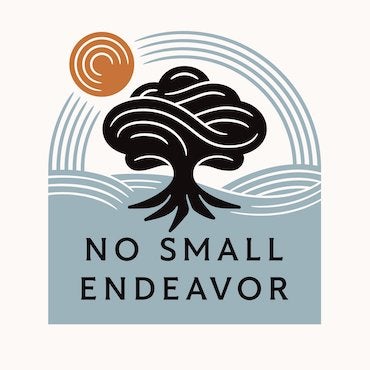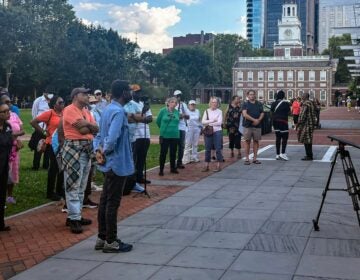What Happened Next: After the state’s probe of Ogontz Avenue Revitalization Corp.

OARC CEO Jack Kitchen in his Cheltenham Avenue office. (Brian Hickey/WHYY)
In July, state Rep. Dwight Evans told NewsWorks that a recently-ended state probe into alleged financial irregularities at the Ogontz Avenue Revitalization Corporation (OARC) boiled down to “political profiling.”
As the state Department of Community & Economic Development (DCED) wrapped up a two-year investigation into OARC’s use of millions in grant dollars and attributed no wrongdoing to the nonprofit, OARC agreed to return $1.2 million in public money, withdraw four grant requests and undergo stricter spending controls.
It marked the end of a lengthy, and pricey, headache for the West Oak Lane-based entity. In early December, OARC President and CEO Jack Kitchen sat down with NewsWorks at his Cheltenham Avenue office to discuss the toll that the investigation took, and how the organization plans to move forward.
What follows is Kitchen’s thoughts on a variety topics related to the probe and West Oak Lane itself.
On the probe
“It was really a three-year ordeal. I’m not pointing fingers at anyone politically, but it was a very difficult time for OARC with mounting legal and accounting bills. It’s a misnomer that [we got monies thanks to a] rubber stamped. There are audits, compliance [reports], unlike WAMs that have no paper trail.
“So many stories about this got it wrong. What happened to fact-checking in journalism? Someone just sent me a story from Jim Foster’s rag [The Independent Voice newspaper, based in Germantown], and I want that written down: Jim Foster’s rag. There’s no one around to hold [journalists’] feet to the fire, to make sure they’re accurate in what they say. No fact-checking at all. [Stories] tried to lump us in with [disgraced former state Sen. Vincent] Fumo and [state Rep. Mike] Veon; Jack and Dwight must be doing that too. (Ed. note: See Foster’s response here and Kitchen’s clarification here.)
“We dug a hole for ourselves with unforseen legal and accounting bills, but we’re getting back on track now. These things hung over our head for a long time. It’s not a pretty situation to go through.
“If [several bankers and lenders] didn’t stand by us, we’d have sunk. I traded on my word, and record of relationships in the past, and now we’ll see our way out of this by March 2014; we’re on our way now, but we had about $2 million in [legal and accounting] bills.
“At the end of it, the DCED said ‘you do great work.’ That makes it so ironic to sit here and look back at what we’ve been through.”
On its impact
“Personally, I never cared about [the slights]. We’ll still be able to do projects. On Ogontz Avenue. In Germantown, the LEED-certified homes on Sprague. On Eastburn Avenue. We’re already back at work, construction already started at 7612-14 Ogontz, a mixed-use project. We might have had to leave those projects behind [without the settlement].
“I didn’t know how it all could not end well, since I knew everything that we did and didn’t do.”
On the post-Jazz-Fest era
“The Night Market [which debuted last summer] has become an annual event now, third week in June, and we have plans to grow the [music event] at the Keswick, which will be held June 21.
“The [now defunct] West Oak Lane did cost $1 million, but people who say there was no transparency are wrong. We had contracts for vendors, producers. There was an annual [report] to DCED. Everything was documented. What people don’t realize to this day is the benefit of the festival for West Oak Lane. It’s substantial.
“Before the festival, people didn’t know about West Oak Lane. I can remember saying ‘we need a hook, we need a hook’ to get people up here. I was digging and digging and digging for something historic to use as that hook.
“Martin Titman was the elderly real estate broker that owned Brody/Titman Real Estate on upper Ogontz Ave. He was the one who discovered the historical feature I was looking for, but unfortunately he claimed that Ogontz Plaza was the first strip center in the United States with off-street parking. This really did not measure up to the historical sites in Germantown.
“Since OARC had always done a community event called ‘Super Saturday’ I decided to build that event into what eventually became the West Oak Lane Jazz Festival, the experience of the people that had produced the Super Saturday was extremely valuable as we moved to an event that was attended from visitors from all around the globe.
“Then, I saw a story about the economic impact of the New Orleans Jazz Festival.
On its lasting impact
“We were looking for a way to showcase all that we were doing here, to market the area, and that’s how it fell together.
“The first year, we had 15-20,000 people here, and there was a 30-percent spike in business revenues. Not only that, but people started coming back even without events. Housing sales took off; 100-150 a year and then 500 at the peak of the festival. The next year after that, it started to decline and I thought, ‘Oh my God, we have a bubble here.’ But then, it leveled off at 200. Now, there are fewer than 50 vacant properties in West Oak Lane.
“That’s something tangible, a direct result of the festival. For the $1 million to put the festival on, the taxes, the real-estate commissions, we’re talking tens of millions of dollars in revenue that we can trace back to the festival. It was absolutely an asset for the community. It served the purpose.
“If it’s something we could pull off in Germantown, it would affect change there as well. The West Oak Lane model can be replicated anywhere.
“West Oak Lane has developed into a community of choice. There were 1,000 people who came through an open house on Ogontz Avenue. They’re turning people away.
“We’ve always wanted West Oak Lane to be stable, because we want to move on and replicate this elsewhere. We looked at tenants who’d been on Ogontz Ave. for 50 years or more. We found Beals Florists, the Hoagie Factory, Martin’s Cleaners and Brownie’s Par Four Bar. The common thread between them? They all owned their property.
“We want to expand that up and down Ogontz Avenue and beyond. Despite all the negativity, we’ve managed to keep positive forces in the community.”
WHYY is your source for fact-based, in-depth journalism and information. As a nonprofit organization, we rely on financial support from readers like you. Please give today.




